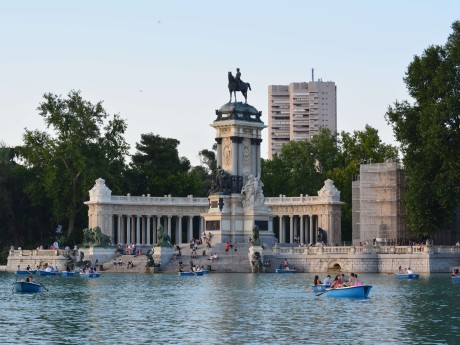Spain: Madrid, Córdoba & Seville
Experience the rich history and culture of Madrid as you stroll through El Retiro Park. Marvel at the Alcazar in Córdoba and watch a live flamenco show while in Seville. Visit the Royal Palace of Madrid, stop at the iconic Prado Museum and shop at the famous Gran Via street while staying in Madrid. In Córdoba, discover one of Andalucia's three great monuments, the Mezquita, a stunning example of Islamic architecture.
Read more
Experience the rich history and culture of Madrid as you stroll through El Retiro Park. Marvel at the Alcazar in Córdoba and watch a live flamenco show while in Seville. Visit the Royal Palace of Madrid, stop at the iconic Prado Museum and shop at the famous Gran Via street while staying in Madrid. In Córdoba, discover one of Andalucia's three great monuments, the Mezquita, a stunning example of Islamic architecture. Also, don't miss the chance to visit the Plaza de la Corredera for a rich experience of history and architecture. In Seville, Spain’s hidden gem, visit the Royal Alcazar, another one of Andalucia’s three great monuments, or the Museum of Fine Arts, which boasts an impressive collection. Whether you're a history buff, an art and culture enthusiast, or simply looking to immerse yourself in the vibrant life of Spain, this journey offers something for everyone! Waterviews strives to offer accommodation options within walking distance of water and/or in an area of touristic interest. Our prices include taxes (but excludes local tourist taxes). Customize your trip to your personal preferences with optional activities (hit the “Add Activities’’) or change hotels, etc. Contact us for customization at no extra cost at: Service@waterviewstravel.com
Destinations
- Madrid
- Córdoba (Spain)
- Seville
- Madrid
Itinerary
Madrid
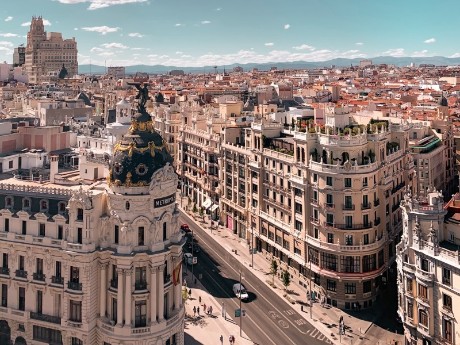
There is hardly any other city that presents the Spanish lifestyle as compactly as the Spanish capital. It combines economy and trade, culture and art with the typical elements of the Spanish way of life. Madrid offers world-class galleries, a wide variety of culinary delights, a legendary nightlife and beautiful architecture. The historic centre of Madrid between the Palace and the Retiro recreation park is relatively well laid out and is an ideal starting point for exploring the city.
Read more
There is hardly any other city that presents the Spanish lifestyle as compactly as the Spanish capital. It combines economy and trade, culture and art with the typical elements of the Spanish way of life. Madrid offers world-class galleries, a wide variety of culinary delights, a legendary nightlife and beautiful architecture. The historic centre of Madrid between the Palace and the Retiro recreation park is relatively well laid out and is an ideal starting point for exploring the city.
Additional Information
Location
Madrid is just northeast of the geographical center of the Iberian Peninsula, in the middle of the Spanish central Castillian plateau (Meseta central), at an average altitude of . Nearly all of the most famous tourist areas are in the center of the city including Puerta del Sol, Plaza Mayor, Palacio Real, and Plaza de Colón. The major streets in Madrid include the Gran Via, Alcalá Street, and Paseo de la Castellana.
Climate
The climate of Madrid is continental; mainly dry and quite extreme at times. Madrid sees perpetual sunshine and a characteristically hot and dry summer, and a fairly cold winter with frequent frosts during the night and the occasional snowfall. Spring and autumn are mild with the most rainfall concentrated in these seasons. Spring and autumn are definitely the best times to visit, especially the months of April, May, June, September and October. There is very little rainfall during summer and also less rainfall during winter. During winter snow occurs sporadically; however, snowfall usually lasts only for a few days, but there is abundant snowfall in the adjacent mountain ranges nearby.
History
Madrid is a city that goes back to the Spanish Muslims, but virtually nothing of Madrid before the Reconquista is left. A few historic city walls have been archeologically preserved but Madrid was by far overshadowed by Toledo (Roman Toletum) until the early modern era. To give just one example, construction on Madrid Cathedral did not start until the late 19th century (and construction only finished in the 1990s) as the archbishop of Toledo did not want to relinquish episcopal power.
The culture of Madrid was dominated by its royal history, centre of the Spanish Empire. The Royal Palace, big plazas and buildings used by the Spanish Monarchy, enormous cathedrals and churches are plentiful in Madrid. Madrid is now just as much a cosmopolitan city as Berlin or London: full of modern architecture, lifestyle and culture.
Madrid became capital of Spain under Phillip II (Felipe II in Spanish) who had a gargantuan palace built in nearby El Escorial. For a long while, Madrid would be the royal residence first, and a city only later. Madrid architecture often reflects the era in which it was built. The Spanish Habsburgs ("Los Austrias") who reigned until the death of unfortunate Charles II in 1700 predominantly used red brick for facades and black schist for the roofs. The later Bourbon dynasty (ruling today after the two Republican interludes) preferred granite to brick, giving their buildings a grayer tone. The king that had the largest influence on Madrid after Felipe II was perhaps Carlos III. He was nicknamed "el Rey Alcalde" (the mayor-king) or "Madrid's best mayor" due to his extensive building and modernization programs in the city. Other royal projects that left their mark are Isabel II's freshwater canal, and the metro which was started in 1919 with King Alfonso XIII's own money. However, both those monarchs were so unpopular that they were later overthrown by their own people, giving rise to the First and Second Spanish Republics.
Being the capital of Spain, Madrid came to be associated - justly or not - with the governing trends in Spain by Spaniards in other parts of the country. As the governing trends swung widely from anti-clerical Republic to hyper-catholic fascist Franco dictatorship, this has influenced the perception of Madrid in the rest of Spain. During the 2nd Republic (1931-1936), it was a bustling city of new ideas with many political issues of the day literally fought out on the streets of Madrid. During the Civil War, Madrid endured a three year siege (1936-1939) by the anti-Republican troops and was one of the last places to hold out for the Republic. During the dictatorship of Francisco Franco (1939-1975), the city represented the heart of the repressive hyper-conservative dictatorship to many Spaniards, particularly Basques and Catalans. However, the city is also the epicentre of the famous Movida of the 1980s, a Spanish movement that bred personalities such as the director Pedro Almodóvar. The heritage of this era is indeed still visible in the city center, where a party can be found at all times and one of the most liberal and colourful environments of Spain can be seen. The city is also known for its acceptance of LGBT people. Madrid's city politics have swung widely from right to left and back since the death of Franco, at first having a PSOE led government through the eighties which was replaced by the center-right PP which dominated the city through corruption and paternalistic public works in the 1990s only to give rise to ex-communist Manuela Carmena in the 2010s (after the corruption came to light with several high ranking Madrid PP members ending up in jail) who was replaced (despite her personal popularity) by a coalition including the neo-Franquist VOX party after the 2019 elections
A massive expansion of the Madrid Metro network began in the mid-1990s and only slowed down by the 2008/2009 economic crisis. It has given the city an urban transit system with few equals in the world. The city which for centuries could not compete with other European capitals has become a quite vibrant and cosmopolitan place with immigrants from Latin America, Arab countries, other parts of Europe, and the Iberian peninsula.
Madrileños everyday
The citizens of Madrid refer to themselves as Madrileños or the more traditional and now seldom-used term "gatos" (cats). They live by a daily routine that is heavily influenced by the climate. Due to the typically midday heat during summer, a "siesta" can be still observed during which some citizens take a break to cool off, though Madrileños can usually only afford this 'luxury' during holidays and weekends.
Most stores are open throughout the day; just small stores are often closed during siesta. Workers and those more afflicted by Western lifestyles choose not to observe this long break and work usually between 09:00 and 18:00-19:00. However, during summer, many offices have a summer schedule requiring workers to start at 08:00 and finish at 15:00 (most commonly without the standard 1-2 hour break for lunch).
Offices usually close during the weekend but businesses are often open Saturday morning (downtown stays open until afternoon). Most grocers are closed on Sundays, but some major chain and department stores linked to "culture" (books, music, etc.) will be open throughout the day and all of them on the first Sunday of the month. Shops and department stores in Puerta del Sol area are open every day.
Madrid has a very modern and elaborate transportation network of buses and Metro with a few "Light Metro" tram lines in the outskirts. The city contrasts with some large European cities in that it is extremely clean, and city employees in bright yellow vests can almost always be seen cleaning the streets and sidewalks. Like most large cities, however, there is a substantial population of vagrants and beggars lining the streets.
Madrid is one of the biggest and most cosmopolitan cities in Europe. Communities of West Africans, North Africans, other Europeans, Chinese, Indians, Filipinos, Pakistanis and (especially) Latin Americans are prominent.
Nightlife
Madrid possibly has the most bars per capita of any European city and a very active nightlife; Madrileños are known to stay up until as late as 05:00-07:00. It is quite common to see a crowded Gran Vía on weekend nights. Due to this lifestyle, lodging near the fun areas may end up a nightmare for light sleepers if your window faces the street.
© Sourced from Wikivoyage
Córdoba (Spain)
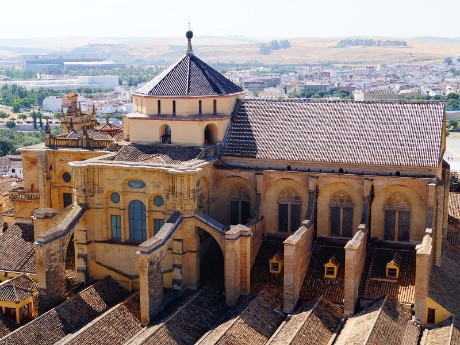
As one of Spain’s most beautiful and mesmerising cities, Córdoba dazzles with its diverse historical buildings, which mix influences from Moorish, Medieval and Roman times. The main draw is the Mezquita, a world-famous and intricately decorated mosque built while Spain was the capital of Islamic Europe. Get lost in the city’s winding streets and soak up its enchanting atmosphere in one of the many bars and tapas restaurants.
Read more
As one of Spain’s most beautiful and mesmerising cities, Córdoba dazzles with its diverse historical buildings, which mix influences from Moorish, Medieval and Roman times. The main draw is the Mezquita, a world-famous and intricately decorated mosque built while Spain was the capital of Islamic Europe. Get lost in the city’s winding streets and soak up its enchanting atmosphere in one of the many bars and tapas restaurants.
Additional Information
Very few places in the world can boast of having been the capital of a Roman province (Hispania Ulterior), the capital of an Arab State (Al-Andalus) and a Caliphate. Such splendor is palpable in the intellectual wealth of this city, that has seen the birth of figures like Seneca, Averroes, and Maimonides. The historic quarter of Córdoba is a beautiful network of small streets, alleys, squares and whitewashed courtyards arranged around the Mezquita, which reflects the city's prominent place in the Islamic world during medieval times.
Córdoba also has much to offer in terms of art, culture and leisure, thanks to a myriad of cultural events that are organized here throughout the year: Flamenco festivals, concerts, ballet and other activities. These events are complemented by a number of museums and a good nightlife scene.
© Sourced from Wikivoyage
Seville
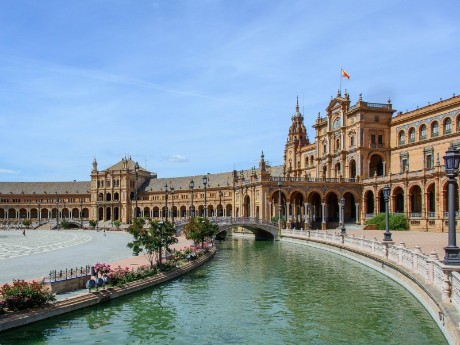
Seville, located on the banks of the Guadalquivir River, is the fourth largest city in Spain and presents itself as a very diverse destination with a history going back more than two thousand years. The city has one of the largest Old Town areas in Europe and is famous for its beautiful architecture and rich culture. In 1992 Seville was also the venue of the World Expo. The bustling art & folklore scene, numerous festivals and a thriving nightlife make Seville an exceptionally attractive destination.
Read more
Seville, located on the banks of the Guadalquivir River, is the fourth largest city in Spain and presents itself as a very diverse destination with a history going back more than two thousand years. The city has one of the largest Old Town areas in Europe and is famous for its beautiful architecture and rich culture. In 1992 Seville was also the venue of the World Expo. The bustling art & folklore scene, numerous festivals and a thriving nightlife make Seville an exceptionally attractive destination.
Additional Information
The smooth, slow Guadalquivir River flows through Seville, known as Betis by the Romans and as Betik Wahd-Al-Khabir by the Arabs. Since it is hard to navigate upstream from Seville, the cereal-producing region starts here, and Seville has been a busy port from Roman times, under Muslim rule, and exploding during the Age of Discovery. As the monopoly was broken and Cádiz largely took Seville's place, the city entered a period of relative decline.
In the 19th century Seville gained a reputation for its architecture and culture and was a stop along the Romantic "Grand Tour" of Europe. Seville has built on its tourism industry since, playing host to the International Exposition in 1992, which spurred the construction of a new airport, a new train station, a bullet train link to Madrid, new bridges and improvements to the main boulevards. Tourist facilities are top-notch and the city is buzzing with festivals, color and a thriving nightlife scene.
© Sourced from Wikivoyage
Madrid
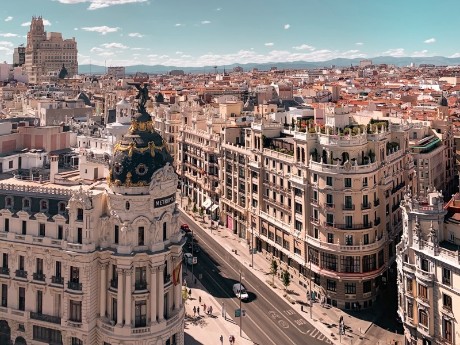
There is hardly any other city that presents the Spanish lifestyle as compactly as the Spanish capital. It combines economy and trade, culture and art with the typical elements of the Spanish way of life. Madrid offers world-class galleries, a wide variety of culinary delights, a legendary nightlife and beautiful architecture. The historic centre of Madrid between the Palace and the Retiro recreation park is relatively well laid out and is an ideal starting point for exploring the city.
Read more
There is hardly any other city that presents the Spanish lifestyle as compactly as the Spanish capital. It combines economy and trade, culture and art with the typical elements of the Spanish way of life. Madrid offers world-class galleries, a wide variety of culinary delights, a legendary nightlife and beautiful architecture. The historic centre of Madrid between the Palace and the Retiro recreation park is relatively well laid out and is an ideal starting point for exploring the city.
Additional Information
Location
Madrid is just northeast of the geographical center of the Iberian Peninsula, in the middle of the Spanish central Castillian plateau (Meseta central), at an average altitude of . Nearly all of the most famous tourist areas are in the center of the city including Puerta del Sol, Plaza Mayor, Palacio Real, and Plaza de Colón. The major streets in Madrid include the Gran Via, Alcalá Street, and Paseo de la Castellana.
Climate
The climate of Madrid is continental; mainly dry and quite extreme at times. Madrid sees perpetual sunshine and a characteristically hot and dry summer, and a fairly cold winter with frequent frosts during the night and the occasional snowfall. Spring and autumn are mild with the most rainfall concentrated in these seasons. Spring and autumn are definitely the best times to visit, especially the months of April, May, June, September and October. There is very little rainfall during summer and also less rainfall during winter. During winter snow occurs sporadically; however, snowfall usually lasts only for a few days, but there is abundant snowfall in the adjacent mountain ranges nearby.
History
Madrid is a city that goes back to the Spanish Muslims, but virtually nothing of Madrid before the Reconquista is left. A few historic city walls have been archeologically preserved but Madrid was by far overshadowed by Toledo (Roman Toletum) until the early modern era. To give just one example, construction on Madrid Cathedral did not start until the late 19th century (and construction only finished in the 1990s) as the archbishop of Toledo did not want to relinquish episcopal power.
The culture of Madrid was dominated by its royal history, centre of the Spanish Empire. The Royal Palace, big plazas and buildings used by the Spanish Monarchy, enormous cathedrals and churches are plentiful in Madrid. Madrid is now just as much a cosmopolitan city as Berlin or London: full of modern architecture, lifestyle and culture.
Madrid became capital of Spain under Phillip II (Felipe II in Spanish) who had a gargantuan palace built in nearby El Escorial. For a long while, Madrid would be the royal residence first, and a city only later. Madrid architecture often reflects the era in which it was built. The Spanish Habsburgs ("Los Austrias") who reigned until the death of unfortunate Charles II in 1700 predominantly used red brick for facades and black schist for the roofs. The later Bourbon dynasty (ruling today after the two Republican interludes) preferred granite to brick, giving their buildings a grayer tone. The king that had the largest influence on Madrid after Felipe II was perhaps Carlos III. He was nicknamed "el Rey Alcalde" (the mayor-king) or "Madrid's best mayor" due to his extensive building and modernization programs in the city. Other royal projects that left their mark are Isabel II's freshwater canal, and the metro which was started in 1919 with King Alfonso XIII's own money. However, both those monarchs were so unpopular that they were later overthrown by their own people, giving rise to the First and Second Spanish Republics.
Being the capital of Spain, Madrid came to be associated - justly or not - with the governing trends in Spain by Spaniards in other parts of the country. As the governing trends swung widely from anti-clerical Republic to hyper-catholic fascist Franco dictatorship, this has influenced the perception of Madrid in the rest of Spain. During the 2nd Republic (1931-1936), it was a bustling city of new ideas with many political issues of the day literally fought out on the streets of Madrid. During the Civil War, Madrid endured a three year siege (1936-1939) by the anti-Republican troops and was one of the last places to hold out for the Republic. During the dictatorship of Francisco Franco (1939-1975), the city represented the heart of the repressive hyper-conservative dictatorship to many Spaniards, particularly Basques and Catalans. However, the city is also the epicentre of the famous Movida of the 1980s, a Spanish movement that bred personalities such as the director Pedro Almodóvar. The heritage of this era is indeed still visible in the city center, where a party can be found at all times and one of the most liberal and colourful environments of Spain can be seen. The city is also known for its acceptance of LGBT people. Madrid's city politics have swung widely from right to left and back since the death of Franco, at first having a PSOE led government through the eighties which was replaced by the center-right PP which dominated the city through corruption and paternalistic public works in the 1990s only to give rise to ex-communist Manuela Carmena in the 2010s (after the corruption came to light with several high ranking Madrid PP members ending up in jail) who was replaced (despite her personal popularity) by a coalition including the neo-Franquist VOX party after the 2019 elections
A massive expansion of the Madrid Metro network began in the mid-1990s and only slowed down by the 2008/2009 economic crisis. It has given the city an urban transit system with few equals in the world. The city which for centuries could not compete with other European capitals has become a quite vibrant and cosmopolitan place with immigrants from Latin America, Arab countries, other parts of Europe, and the Iberian peninsula.
Madrileños everyday
The citizens of Madrid refer to themselves as Madrileños or the more traditional and now seldom-used term "gatos" (cats). They live by a daily routine that is heavily influenced by the climate. Due to the typically midday heat during summer, a "siesta" can be still observed during which some citizens take a break to cool off, though Madrileños can usually only afford this 'luxury' during holidays and weekends.
Most stores are open throughout the day; just small stores are often closed during siesta. Workers and those more afflicted by Western lifestyles choose not to observe this long break and work usually between 09:00 and 18:00-19:00. However, during summer, many offices have a summer schedule requiring workers to start at 08:00 and finish at 15:00 (most commonly without the standard 1-2 hour break for lunch).
Offices usually close during the weekend but businesses are often open Saturday morning (downtown stays open until afternoon). Most grocers are closed on Sundays, but some major chain and department stores linked to "culture" (books, music, etc.) will be open throughout the day and all of them on the first Sunday of the month. Shops and department stores in Puerta del Sol area are open every day.
Madrid has a very modern and elaborate transportation network of buses and Metro with a few "Light Metro" tram lines in the outskirts. The city contrasts with some large European cities in that it is extremely clean, and city employees in bright yellow vests can almost always be seen cleaning the streets and sidewalks. Like most large cities, however, there is a substantial population of vagrants and beggars lining the streets.
Madrid is one of the biggest and most cosmopolitan cities in Europe. Communities of West Africans, North Africans, other Europeans, Chinese, Indians, Filipinos, Pakistanis and (especially) Latin Americans are prominent.
Nightlife
Madrid possibly has the most bars per capita of any European city and a very active nightlife; Madrileños are known to stay up until as late as 05:00-07:00. It is quite common to see a crowded Gran Vía on weekend nights. Due to this lifestyle, lodging near the fun areas may end up a nightmare for light sleepers if your window faces the street.
© Sourced from Wikivoyage




